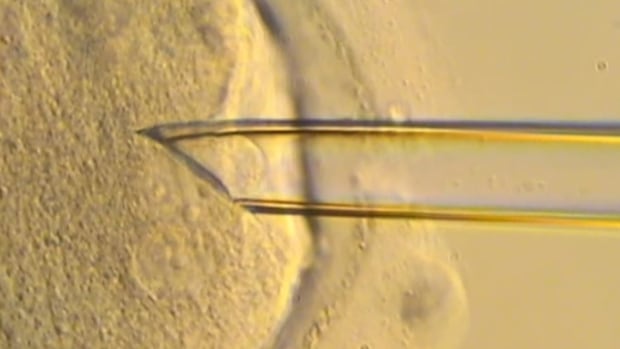8 babies born with experimental 3-parent IVF technique
Donor egg mitochondria, the battery of a cell, replaces faulty mitochondria from mother's egg
Eight healthy babies were born in Britain with the help of an experimental technique that uses DNA from three people to help mothers avoid passing devastating rare diseases to their children, researchers report.
Most DNA is found in the nucleus of our cells, and it's that genetic material — some inherited from mom, some from dad — that makes us who we are. But there's also some DNA outside of the cell's nucleus, in structures called mitochondria. Dangerous mutations there can cause a range of diseases in children that can lead to muscle weakness, seizures, developmental delays, major organ failure and death.
Testing during the in vitro fertilization process can usually identify whether these mutations are present. But in rare cases, it's not clear.
Researchers have been developing a technique that tries to avoid the problem by using the healthy mitochondria from a donor egg. They reported in 2023 that the first babies had been born using this method, where scientists take genetic material from the mother's egg or embryo, which is then transferred into a donor egg or embryo that has healthy mitochondria but the rest of its key DNA removed.
The latest research "marks an important milestone," said Dr. Zev Williams, who directs the Columbia University Fertility Center in New York and was not involved in the work. "Expanding the range of reproductive options ... will empower more couples to pursue safe and healthy pregnancies."
Using this method means the embryo has DNA from three people — from the mother's egg, the father's sperm and the donor's mitochondria — and it required a 2016 U.K. law change to approve it. It is also allowed in Australia but not in many other countries, including the U.S. and Canada.
Experts at Britain's Newcastle University and Monash University in Australia reported in the New England Journal of Medicine Wednesday that they performed the new technique in fertilized embryos from 22 patients, which resulted in eight babies that appear to be free of mitochondrial diseases at a few months to more than two years old. One woman is still pregnant.

One of the eight babies born had slightly higher than expected levels of abnormal mitochondria, said Robin Lovell-Badge, a stem cell and developmental genetics scientist at the Francis Crick Institute in London who was not involved in the research. He said it was still not considered a high enough level to cause disease, but should be monitored as the baby develops.
Andy Greenfield, a reproductive health expert at the University of Oxford, called the work "a triumph of scientific innovation," and said the method of exchanging mitochondria would only be used for a small number of women for whom other ways of avoiding passing on genetic diseases, like testing embryos at an early stage, was not effective.
Lovell-Badge said the amount of DNA from the donor is insignificant, noting that any resulting child would have no traits from the woman who donated the healthy mitochondria. The genetic material from the donated egg makes up less than one per cent of the baby born after this technique.
Challenging life
"If you had a bone marrow transplant from a donor ... you will have much more DNA from another person," he said.
About one in 5,000 children has a disorder tied to mitochondrial mutations, scientists say. Various systems like visual and organs like the brain, heart and kidneys can be affected with varying degrees of severity.
Dr. Mark Tarnopolsky, a professor of pediatrics at McMaster Children's Hospital in Hamilton, said he's seen at least two dozen families with children who died of mitochondrial diseases.
"You know that that child is going to have a very short life and is going to have a very challenging life," Tarnopolsky said of some embryo screening for likelihood of mitochondrial diseases resulting in strokes and seizures. "Then, you know, the couples will usually take the choice to abort."
The hospital has also healthy children born after screening embryos with very low to nonexistent burden of mitochondrial disease, he said.
Ethical considerations to weigh
To consider moving toward mitochondrial donation in Canada, Tarnopolsky said, the genetic variant would need to be 100 per cent related to causing the disease with appropriate checks and balances in place, given eugenic concerns and to guard against "charlatans."
In the U.K., every couple seeking a baby born through donated mitochondria must be approved by the country's fertility regulator. As of this month, 35 patients have been authorized to undergo the technique.

But doctors in Canada and the U.S. warn it's impossible to know the impact these sorts of novel techniques might have on future generations.
"To kind of open the gate wide and introduce it over the world, I feel it's a little premature," said Dr. Paul Chang, a reproductive endocrinologist in Toronto and president of the Canadian Fertility and Andrology Society.
"Although for some family they're running out of time, overall for the health of the greater good, sometimes I do find a little bit of patience and proper research can go a long way."
Andrea Boland, 37, of Toronto is partially sighted due to Leber hereditary optic neuropathy (LHON), a rare mitochondrial disease that her mother unknowingly passed on to her and her brother. Boland was diagnosed in 2017, when she was 29.
"it would be really difficult for me to live with that guilt," she said of the possibility of passing on the disease to future children.
Boland said she's grateful doctors are looking into options but is frustrated with the red tape.
With files from CBC's Amina Zafar
